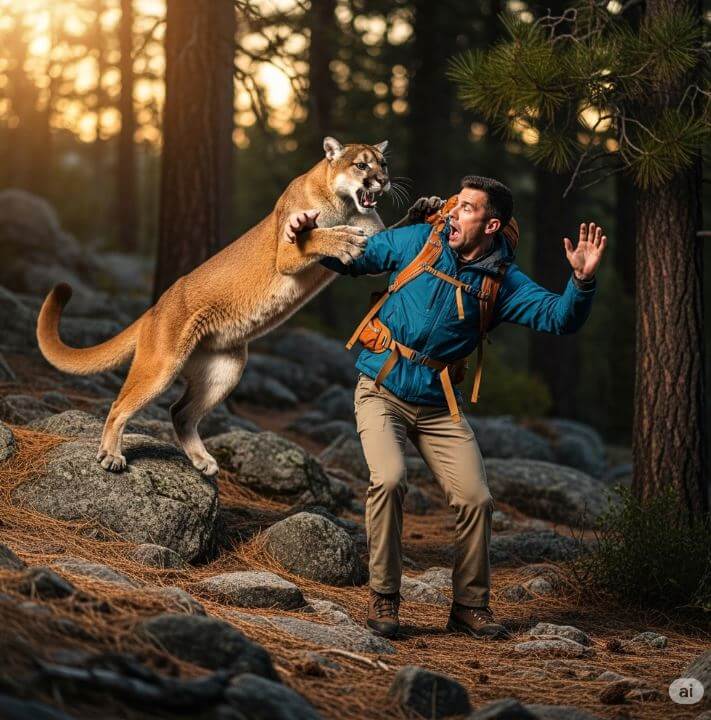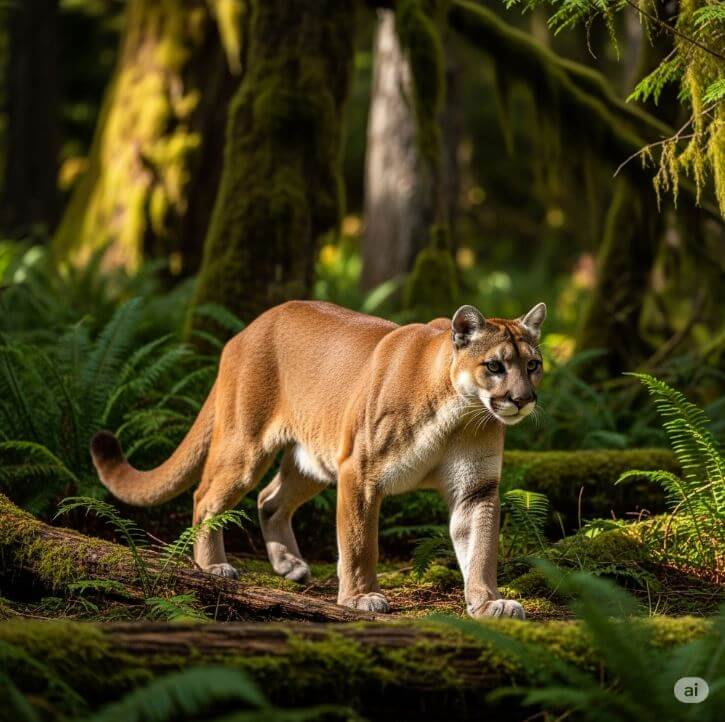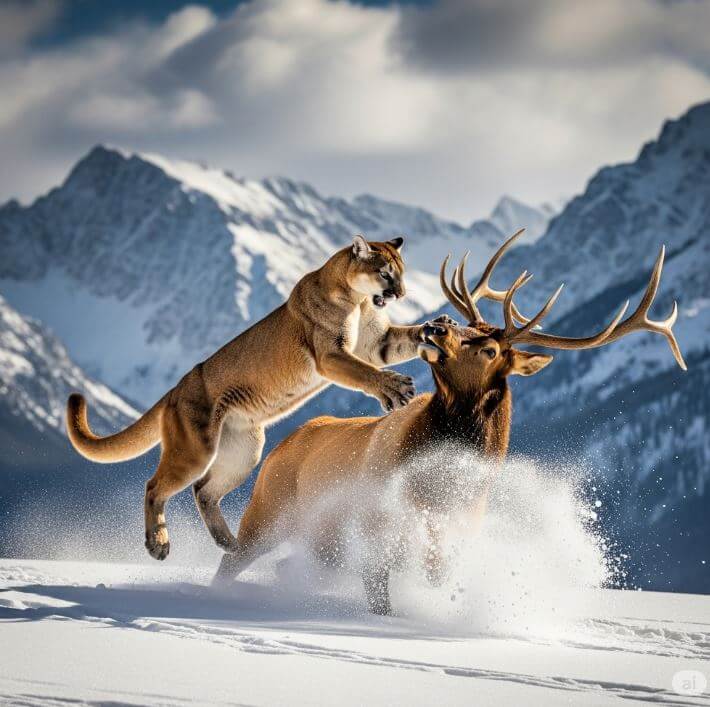A recent incident in Washington’s Olympic National Park has drawn significant attention to wildlife safety, as a 4-year-old child sustained injuries from a mountain lion. The event, which occurred on Sunday, July 20, 2025, near the Victoria Overlook area on Hurricane Ridge, a popular mountain destination within the park, underscores the inherent wildness of these protected landscapes. Following the attack, the child was airlifted to a trauma center in Seattle for treatment. Park officials acted swiftly, locating and “dispatching” the collared animal by Monday, July 21, and assured the public that there were no current threats. This rapid and decisive response highlights the park’s established protocols for managing dangerous wildlife encounters, prioritizing visitor safety above all else. The immediate communication regarding the neutralization of the threat also serves to manage public perception and maintain confidence in the park’s safety measures.
Contents
Incident Details and Official Response

The attack unfolded on Sunday, July 20, 2025, with rangers receiving notification around 3:15 p.m. The 4-year-old was walking with their family on a well-trafficked trail near the Victoria Overlook on Hurricane Ridge when a collared mountain lion bit the child. Eyewitness accounts, including one from hiker Steve Murrow, indicate that the child’s father courageously intervened, wrestling the child from the animal’s grasp. Murrow remarked, “I don’t think that kid would survive if it wasn’t for his dad jumping in”.
The emergency response was swift and coordinated. Clallam County Fire District 2 paramedics and park staff quickly arrived at the scene, and the injured child was transferred via LifeFlight to a Level 1 Trauma Center in Seattle. The child has since been reported to be in satisfactory condition and was later discharged.
Immediately following the incident, park rangers initiated a search for the cougar. A canine tracking team joined the effort around 5 p.m. on Sunday, and the animal was located shortly thereafter. The mountain lion was “dispatched,” a term generally referring to euthanasia, on Monday, July 21. The incident remains under investigation, and park officials are actively seeking witnesses, urging anyone with information to contact the National Park Service. To protect the child’s privacy, identifying details will not be released. The explicit request for witnesses, even after the animal was removed, suggests a commitment to understanding the specific circumstances of the attack, which can inform future safety protocols and public education. This goes beyond merely resolving the immediate danger, aiming to learn from the event for long-term wildlife management and visitor safety strategies. The detailed timeline of the response, from notification to dispatch, involving multiple agencies, demonstrates the park’s robust emergency infrastructure and inter-agency cooperation. This level of detail in official communications helps build public trust in the park’s ability to handle crises effectively.
Understanding Mountain Lion Behavior and Attack Rarity

Mountain lions, also known as cougars, pumas, or ghost cats, are North America’s largest wild cats. They are renowned for their elusive nature and stealth as apex predators. These solitary animals are primarily active during dusk and dawn, a behavior known as crepuscular, and are territorial, requiring extensive wilderness habitats to thrive. Their diet predominantly consists of deer, but they are opportunistic carnivores, capable of preying on smaller animals or even insects when necessary. Mountain lions typically hunt by stalking their prey and delivering a lethal bite to the spinal cord from behind.
Attacks on humans are exceptionally rare. Historical data from 1890 to 1990 indicates only 53 cougar attacks in the U.S. and Canada, with just 9 resulting in fatalities (accounting for 10 deaths). This translates to approximately one attack every two years. Even with more recent data from 1990 to 2018 in the U.S. alone, there have been only 11 fatal incidents. While sightings of mountain lions have increased significantly, actual attacks remain uncommon. The perception of risk often outweighs the statistical probability. Despite the infrequency of these events, their severe and dramatic nature makes them highly newsworthy, potentially amplifying public apprehension beyond the actual statistical danger.
When attacks do occur, they are typically driven by hunger, particularly for females needing to feed their kittens, or when a mountain lion perceives a human as vulnerable prey. Running from a mountain lion can trigger their natural chase instinct, as it mimics the behavior of prey animals. Attacks can also be a consequence of the animal being injured, struggling to find its usual prey, or experiencing encroachment on its habitat. Understanding that these attacks are primarily predatory rather than defensive is crucial for developing effective safety strategies.
In Washington state, fatal mountain lion attacks are extremely rare, with only a few confirmed over the past century, including a child in 1924 and a bicyclist in 2018. This historical context helps to provide perspective, demonstrating that while serious, the recent event is not unprecedented and such incidents remain infrequent over a long period. However, data indicates an upward trend in human-cougar interactions. Nationwide, attacks averaged about three per year until 1970, jumping to 14 attacks per year throughout the 1990s. Confirmed sightings and incidents of damage to pets and livestock have also risen. This increasing frequency of interactions suggests that human expansion into wildlife habitat and increased park visitation are contributing factors to this trend.
Essential Safety Guidelines for Olympic National Park Visitors
Olympic National Park is known cougar country, with mountain lions inhabiting its nearly one million acres, from coastal areas to high country. Visitors bear responsibility for their own safety and for the well-being of the park’s wildlife. Adhering to safety guidelines is paramount for a safe visit.
Prevention is Key
- Travel in Groups: It is recommended to hike in groups, with adults closely supervising children and keeping them within sight at all times.
- Avoid Peak Activity Times: Mountain lions are most active at dusk and dawn, so avoiding hiking during these times can reduce the chance of an encounter.
- Make Noise: While hiking or biking, making noise can help prevent surprising animals. Some hikers use bells or call out periodically to signal their presence.
- Never Feed Wildlife: Feeding wild animals can alter their natural behaviors, harm their health, and increase risks to humans by habituating animals to human presence and food sources.
- Secure Food and Scented Items: Keep campsites clean and store all food, garbage, and scented items (such as toothpaste) securely in bear canisters or hung from park bear wires.
- Pet Safety: Keep pets on a leash and secure them, as mountain lions may perceive them as prey. Pet food should not be left outdoors. These guidelines extend beyond trail encounters, recognizing that human-wildlife interactions occur at the wildland-urban interface, necessitating a comprehensive approach to safety and coexistence.
If You See a Mountain Lion
- Stay Calm and Do Not Run: Running can trigger a mountain lion’s chase instinct. Instead, remain calm
- Maintain Eye Contact and Back Away Slowly: Hold your ground or slowly retreat, always facing the animal and maintaining direct eye contact.
- Appear Large and Intimidating: Stand tall, raise your arms, open your jacket, and speak firmly in a loud voice to make yourself appear as large as possible. If in a group, stand shoulder-to-shoulder to present a more formidable presence.
- Protect Children and Pets: Immediately pick up small children or pets, if possible, without bending over or turning your back to the animal.
- Avoid Crouching: Do not crouch down or bend over, as this posture can make you resemble a four-legged prey animal.
- Provide an Escape Route: Ensure the mountain lion has a clear path to retreat.
If the Mountain Lion Acts Aggressively or Attacks
- Throw Objects: If the mountain lion moves towards you or acts aggressively, start throwing stones, branches, water bottles, or other available objects in its direction as warning shots.
- Fight Back: If an attack occurs, fight back aggressively with anything at hand, such as sticks, rocks, a backpack, bear spray, or even bare hands. Aim for the body, not necessarily the head. The objective is to convince the cougar that you are not prey but a potential danger. The successful deterrence of an 8-year-old’s attack at Lake Angeles, where the mother’s yelling and screaming caused the cougar to abandon its attack, demonstrates the effectiveness of fighting back.
Reporting Encounters
- Immediate Threats: For immediate public safety issues or attacks, call 911 immediately.
- Non-Emergency Sightings: For non-emergency mountain lion sightings or concerns, submit a Cougar Report Form or contact park staff. It is not necessary to report every sighting, but rather focus on aggressive behavior or actual attacks. This distinction is important for efficient emergency services and public understanding
The detailed safety guidelines provided by the National Park Service and other wildlife agencies often include the rationale behind each recommendation. For example, explaining that “running may stimulate a mountain lion’s instinct to chase” or that “crouching… looks a lot like a four-legged prey animal” enhances the educational value and promotes better compliance. This approach goes beyond mere instruction, educating the public on mountain lion behavior, which can lead to more informed decisions in real-time. The emphasis on maintaining safe distances (e.g., 75 feet from large wildlife, 300 feet from cougars, bears, and wolves in Yellowstone) , not feeding wildlife, and securing food highlights visitor behavior as a crucial factor in preventing encounters. This places a shared responsibility on visitors to contribute to their own safety and wildlife conservation.
Key Mountain Lion Safety Tips for Visitors
| Before Your Hike | During an Encounter | If Attacked | Reporting |
| Hike in groups, supervise children closely. | Stay calm, do not run. | Fight back aggressively. | Call 911 immediately for attacks or immediate threats. |
| Avoid dusk/dawn when lions are most active. | Appear large: stand tall, raise arms, open jacket, speak loudly. | Use anything available: sticks, rocks, backpack, bear spray, bare hands. | For non-emergency sightings/encounters, submit a Cougar Report Form or contact park staff. |
| Make noise to avoid surprises. | Maintain eye contact, back away slowly. | Aim for the body, not necessarily the head. | |
| Never feed wildlife; secure all food and scented items. | Pick up small children/pets without bending. | ||
| Keep pets on leash and secure. | Do not crouch or bend over. | ||
| Give the lion an escape route. | |||
| If aggressive, throw objects in its direction. |
Broader Context: Human-Wildlife Encounters in National Parks

Human-wildlife conflicts are becoming increasingly prevalent across national parks. This trend is primarily driven by record-high visitation numbers, with U.S. National Park Service sites welcoming 332 million visitors in 2024. Simultaneously, increasing human population growth and a growing desire for outdoor recreation lead to greater proximity between people and natural habitats.
The fundamental cause of human-wildlife conflict is the decline and fragmentation of natural habitats due to changing land use patterns, including urban expansion, agriculture, and infrastructure development. As wild animals lose their living space and access to natural food sources, they may venture closer to human activity in search of sustenance.
Visitor behavior and perception also play a significant role. Studies indicate that visitors who prioritize wildlife viewing and photography are sometimes more inclined to approach animals, believing such interaction to be appropriate. This can lead to animals becoming “food-conditioned” or habituated to human presence, thereby increasing the risk of conflict. There is often a “sanitized view” of wild animals, where individuals underestimate the inherent dangers, influenced by high-definition media consumption that creates a disconnect from the reality of wildness. The rise of social media and advanced camera technology contributes to this, as the desire for close-up photos or viral content can inadvertently override safety guidelines, creating more opportunities for conflicts. This creates a dangerous cycle where human actions inadvertently draw wildlife closer, increasing the risk of conflict.
National parks employ various strategies to mitigate these conflicts. Education is a cornerstone, with effective interpretive and educational programs designed to foster a “stewardship ethic” and encourage visitors to adopt safe behaviors. These programs aim to raise awareness, empower communities, and promote informed public engagement. Research suggests that safety campaigns focusing on visitor benefits and avoiding solely fear-based messaging are more effective in promoting compliance. Strict regulations against feeding or disturbing wildlife, maintaining safe distances, and secure food storage are enforced. Beyond education and regulation, habitat protection, through the establishment of national parks and wildlife reserves, is critical for providing animals with necessary space and resources. Wildlife management also includes tracking animals, discouraging them from entering human areas, and, in severe cases, dispatching animals that pose an imminent threat.
While the recent mountain lion attack is serious, it is important to place it within the broader context of national park dangers. Mountain lion attacks are statistically rare compared to other causes of death or injury in parks, such as falls, drownings, medical emergencies, heat-related issues, or climbing mishaps. For example, North Cascades National Park has a significantly higher death rate per 10 million visitors due to falls, drownings, and medical emergencies, and even bison gorings occur in parks like Yellowstone. This comparative perspective helps prevent undue alarm and reframes the incident within a broader safety landscape.
The increase in cougar populations, a positive outcome of conservation efforts, means more animals are present in their historic range, which increasingly overlaps with human recreation. This ecological trend naturally leads to more encounters, even if attacks remain rare. The observation that cougars are killing wolves in Washington also highlights complex ecological dynamics within the park ecosystem, suggesting a healthy predator population, which can indirectly influence prey availability for cougars and thus their behavior.
Mountain Lion Attack Statistics in the U.S. (Selected Periods)
| Period | Total Attacks (US/Canada) | Fatal Attacks (US/Canada) | Fatalities (US/Canada) | Notes |
| 1890-1990 | 53 | 9 | 10 | Approximately 1 attack every 2 years. 38% on Vancouver Island. |
| 1970s | 17 | 4 | – | Nationwide average jumped to 14 attacks/year in 1990s. |
| 1980s | 20 | 2 | – | |
| 1991-1999 | 36 | 7 | – | |
| 1990-2018 (US Only) | – | 11 | – | More deaths than previous 100 years combined, but still low total. |
| Since 1986 (California) | 12 injuries | 2 deaths | – | Injuries mostly to children visiting parks. |
| Washington State | 2 fatal attacks | – | – | 1924 (child), 2018 (bicyclist). |
Exploring Olympic National Park Safely
Olympic National Park is a natural wonderland spanning nearly a million acres, encompassing three distinct ecosystems: lush temperate rainforests, rugged Pacific Coast beaches, and alpine wilderness with towering mountains. Its unique and diverse nature has earned it designations as a UNESCO World Heritage Site and an International Biosphere Reserve. Popular attractions include Hurricane Ridge, known for its dazzling vistas and year-round recreation, the Hoh Rain Forest with its magical trails, and the diverse Olympic Beaches offering extensive exploration. The recent attack occurred on a “popular trail” near Hurricane Ridge , one of the most accessible and frequented mountain destinations in the park. This popularity means higher visitor density in a known mountain lion habitat, which can increase the probability of an encounter, even if the likelihood of an individual visitor being attacked remains low.
While Olympic National Park offers unparalleled natural beauty and numerous recreation opportunities, including hiking, biking, camping, and wildlife viewing , it is imperative that visitors remain vigilant and adhere to all park regulations and safety guidelines. The park’s diverse wildlife, including mountain lions, are a vital and integral part of its ecosystem.
Conclusion
The recent mountain lion incident in Olympic National Park serves as a stark reminder of the wild nature of these protected areas and the critical importance of respecting wildlife. While such incidents are exceptionally rare, the National Park Service and the Washington Department of Fish and Wildlife remain committed to ensuring visitor safety through robust emergency response, ongoing investigations, and comprehensive public education efforts. By understanding mountain lion behavior, diligently adhering to established safety guidelines, and practicing responsible outdoor ethics, visitors can continue to safely enjoy the unparalleled beauty and wilderness of Olympic National Park while contributing to the conservation of its vital ecosystems.
Sources
- AP News: https://apnews.com/article/mountain-lion-bite-child-olympic-national-park-4078041aaa7d444dde726871ee37043d
- Fox13 Seattle: https://www.fox13seattle.com/news/mountain-lion-attack-olympic-national-park
- National Park Service (NPS) News Release: https://www.nps.gov/olym/learn/news/mountain-lion-injures-child-in-olympic-national-park-rangers-seek-witnesses.htm
- Reddit (r/NationalPark): https://www.reddit.com/r/NationalPark/comments/15dtwtd/8yearold_attacked_by_mountain_lion_cougar_in/
- GearJunkie: https://gearjunkie.com/outdoor/mountain-lion-attack-olympic-national-park
- National Park Service (NPS) Olympic Wildlife Safety: https://www.nps.gov/olym/planyourvisit/wildlife-safety.htm
- MountainLion.org: https://mountainlion.org/about-mountain-lions/#:~:text=Mountain%20lions%20are%20solitary%20cats,need%20to%20feed%20growing%20kittens.
- National Wildlife Federation (NWF):(https://www.nwf.org/Educational-Resources/Wildlife-Guide/Mammals/Mountain-Lion)
- UnofficialNetworks (Drone Footage): https://unofficialnetworks.com/2024/09/12/drone-captures-mountain-lion-wandering-beach-olympic-national-park/
- National Park Service (NPS) Point Reyes Mountain Lion Safety: https://www.nps.gov/pore/planyourvisit/yoursafety_mountainlions.htm
- Ketchum Idaho (Mountain Lion Safety): https://www.ketchumidaho.org/administration/page/safety-tips-when-living-close-proximity-mountain-lions
- National Park Service (NPS) Olympic Animals: https://www.nps.gov/olym/learn/nature/animals.htm
- National Park Service (NPS) Olympic Places to Go: https://www.nps.gov/olym/planyourvisit/places-to-go.htm
- Olympic Peninsula: https://olympicpeninsula.org/stories/olympic-national-park/
- UnofficialNetworks (Deadliest Parks): https://unofficialnetworks.com/2025/07/16/chart-deadliest-national-park/
- AFAR Media (Human-Wildlife Trends): https://www.afar.com/magazine/what-to-do-if-you-see-wildlife-in-national-parks
- National Park Service (NPS) Who Is the Bad Guy: https://www.nps.gov/articles/000/who-is-the-bad-guy-here-when-animals-misbehave.htm
- Cal Poly (Newswriting Guidelines): https://ucm.calpoly.edu/guidelines-newswriting
- UF/IFAS EDIS (Broadcast Newswriting):(https://edis.ifas.ufl.edu/publication/WC193)
- U.S. Fish & Wildlife Service (FWS) Mountain Lion Safety: https://www.fws.gov/story/mountain-lion-safety
- City of Port Angeles FAQ:(https://cityofpa.us/FAQ.aspx?QID=205)
- Western Wildlife: https://westernwildlife.org/cougar-felis-concolor/cougar-safety/
- Quora (Why are mountain lions afraid of people):(https://www.quora.com/Why-are-mountain-lions-afraid-of-people)
- Kuhl (Are Mountain Lions Dangerous): https://www.kuhl.com/borninthemountains/are-mountain-lions-dangerous
- Wikipedia (List of fatal cougar attacks): https://en.wikipedia.org/wiki/List_of_fatal_cougar_attacks_in_North_America
- OutsideOnline (Rise/Fall of Cougar Attacks): https://www.outsideonline.com/podcast/rise-fall-cougar-attacks/
- Tchester.org (Lion Attack Statistics): https://tchester.org/sgm/lists/lion_attacks_statistics.html
- Spokesman.com (Slew of Animal Attacks): https://www.spokesman.com/stories/2022/jun/12/slough-of-animal-attacks-highlights-importance-of-/
- WildlifeDrones.net (Preventing Human-Wildlife Conflict): https://wildlifedrones.net/preventing-human-wildlife-conflict/
- USDA APHIS (Innovative Solutions): https://www.aphis.usda.gov/sites/default/files/report-nwrc-2016.pdf
- National Park Service (NPS) Interpretation and Education: https://www.nps.gov/subjects/policy/mp-7-interpretation-education.htm
- Reptile Encounters (Education Impact): https://www.reptileencounters.com.au/news/impact-of-eductaion-on-wildlife-survival
- National Parks Conservation Association (NPCA) Endangering Wildlife: https://www.npca.org/case-studies/endangering-park-wildlife
- Colorado Parks and Wildlife (Crossing Paths): https://cpw.state.co.us/crossing-paths-wildlife
- International Fund for Animal Welfare (IFAW) Human-Wildlife Conflict: https://www.ifaw.org/journal/what-is-human-wildlife-conflict
- NOAA Institutional Repository (Safe Wildlife Viewing Campaign):(https://repository.library.noaa.gov/view/noaa/52434/noaa_52434_DS1.pdf)
- Taylor & Francis Online (Safe Wildlife Viewing Campaign): https://www.tandfonline.com/doi/full/10.1080/17524032.2019.1649291
